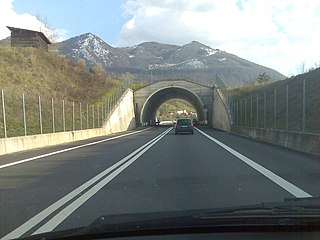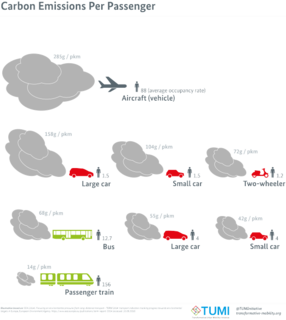In transportation, platooning or flocking is a method for driving a group of vehicles together. It is meant to increase the capacity of roads via an automated highway system.

A self-driving car, also known as an autonomous vehicle (AV), connected and autonomous vehicle (CAV), driverless car, robo-car, or robotic car, is a vehicle that is capable of sensing its environment and moving safely with little or no human input.

Advanced driver-assistance systems (ADAS), are electronic systems that help the vehicle driver while driving or during parking. When designed with a safe human-machine interface, they are intended to increase car safety and more generally road safety. ADAS systems use electronic technology such as microcontroller units (MCU), electronic control units (ECU), and power semiconductor devices, and software technology components such as an Electronic Horizon.

In road-transport terminology, a lane departure warning system (LDWS) is a mechanism designed to warn the driver when the vehicle begins to move out of its lane on freeways and arterial roads. These systems are designed to minimize accidents by addressing the main causes of collisions: driver error, distractions and drowsiness. In 2009 the U.S. National Highway Traffic Safety Administration (NHTSA) began studying whether to mandate lane departure warning systems and frontal collision warning systems on automobiles.

Vehicular automation involves the use of mechatronics, artificial intelligence, and multi-agent system to assist a vehicle's operator. These features and the vehicles employing them may be labeled as intelligent or smart. A vehicle using automation for difficult tasks, especially navigation, may be referred to as semi-autonomous. A vehicle relying solely on automation is consequently referred to as robotic or autonomous. After the invention of the integrated circuit, the sophistication of automation technology increased. Manufacturers and researchers subsequently added a variety of automated functions to automobiles and other vehicles.

Adaptive cruise control (ACC) is an available cruise control system for road vehicles that automatically adjusts the vehicle speed to maintain a safe distance from vehicles ahead. As of 2019, it is also called by 20 unique names that describe that basic functionality. This is also known as Dynamic cruise control.

Energy-efficient driving techniques are used by drivers who wish to reduce their fuel consumption, and thus maximize fuel efficiency. The use of these techniques is called "hypermiling".

Safe Road Trains for the Environment (SARTRE) is a European Commission-funded project to investigate and trial technologies and strategies for the safe platooning of road vehicles, a transportation concept in which several vehicles are electronically linked together in a "road train", with only the lead driver in active control. The three-year project was launched in 2009. The research and development was carried out by several European auto manufactures with Volvo at the lead. A first practical test successfully took place in December 2010. In September Volvo announced that the SARTRE research project had come to a close, and that the company was ready to look into putting its finished product on the road.

Mobileye is an Israeli subsidiary of Intel corporation that develops vision-based self-driving car and advanced driver-assistance systems (ADAS) providing warnings for collision prevention and mitigation. Mobileye headquarters and main R&D centre is located in Jerusalem operating under the company name Mobileye Vision Technology Ltd. The company also has sales and marketing offices in Midtown, Manhattan; Shanghai, China; Tokyo, Japan and Düsseldorf, Germany.

Experiments have been conducted on self-driving cars since at least the 1920s; promising trials took place in the 1950s and work has proceeded since then. The first self-sufficient and truly autonomous cars appeared in the 1980s, with Carnegie Mellon University's Navlab and ALV projects in 1984 and Mercedes-Benz and Bundeswehr University Munich's Eureka Prometheus Project in 1987. Since then, numerous major companies and research organizations have developed working autonomous vehicles including Mercedes-Benz, General Motors, Continental Automotive Systems, Autoliv Inc., Bosch, Nissan, Toyota, Audi, Volvo, Vislab from University of Parma, Oxford University and Google. In July 2013, Vislab demonstrated BRAiVE, a vehicle that moved autonomously on a mixed traffic route open to public traffic.
Emergency Assist is a driver assistance system that monitors driver behavior by observing delays between the use of the accelerator and the brake; once a preset threshold of time has been exceeded the system will take control of the vehicle in order to bring it to a safe stop. This technology is actually a merging of several Level 1 self-driving car technologies, such as Adaptive Cruise Control, Side Assist, Lane Assist, and Park Assist that are utilize to effectively achieve a Level 3 operation, the single environment in which the vehicle operates automatically being when it infers that there is an emergency. Most vehicle manufacturers now offer an Emergency Driver Assistant feature on their more recent, high-end models, taking advantage of the standardization of low-level driver assistance systems in such models. Such manufacturers include Tesla, Inc., Volkswagen, and Audi.
A Robo-Taxi, also known as a Robo-Cab, a self-driving taxi or a driverless taxi is an autonomous car operated for an e-hailing service.

Tesla Autopilot is a suite of advanced driver-assistance system features offered by Tesla that has lane centering, traffic-aware cruise control, self-parking, automatic lane changes, semi-autonomous navigation on limited access freeways, and the ability to summon the car from a garage or parking spot. In all of these features, the driver is responsible and the car requires constant supervision. The company claims the features reduce accidents caused by driver negligence and fatigue from long-term driving.
Peloton Technology is an American automated and connected vehicle technology company established in 2011 and headquartered in Mountain View, California. It is developing a vehicle "platooning" system to enable pairs of trucks to operate at close following distances with a stated goal of improving safety and fuel efficiency. Peloton Technology was the first company to test a non-research commercial truck platooning system on public roads in the United States. In 2016 it publicly stated it would be the first company to offer a commercial platooning system for use by truck fleets in 2017. By mid-2018 that deadline had slipped to "by the end of 2018."
Increases in the use of autonomous car technologies are causing incremental shifts in the responsibility of driving, with the primary motivation of reducing the frequency of traffic collisions. Liability for incidents involving self-driving cars is a developing area of law and policy that will determine who is liable when a car causes physical damage to persons or property. As autonomous cars shift the responsibility of driving from humans to autonomous car technology, there is a need for existing liability laws to evolve in order to reasonably identify the appropriate remedies for damage and injury. As higher levels of autonomy are commercially introduced, the insurance industry stands to see higher proportions of commercial and product liability lines, while personal automobile insurance shrinks.

NIO is a Chinese automobile manufacturer headquartered in Shanghai, specializing in designing and developing electric autonomous vehicles. The company is also involved in the FIA Formula E Championship, the first single-seater, all-electric racing series.

In road-transport terminology, lane centering, also known as auto steer, is a mechanism designed to keep a car centered in the lane, relieving the driver of the task of steering. Lane centering is similar to lane departure warning, but rather than warn the driver, or bouncing the car away from the lane edge, it keeps the car centered in the lane. Together with adaptive cruise control (ACC), this feature may allow unassisted driving for some length of time.
The death of Elaine Herzberg was the first recorded case of a pedestrian fatality involving a self-driving (autonomous) car, after a collision that occurred late in the evening of March 18, 2018. Herzberg was pushing a bicycle across a four-lane road in Tempe, Arizona, United States, when she was struck by an Uber test vehicle, which was operating in self-drive mode with a human safety backup driver sitting in the driving seat. Herzberg was taken to the local hospital where she died of her injuries.
Pedestrian crash avoidance mitigation (PCAM) systems, also known as pedestrian protection or detection systems, use computer and artificial intelligence technology to recognize pedestrians and bicycles in an automobile's path to take action for safety. PCAM systems are often part of a pre-collision system available in several high end car manufacturers, such as Volvo and Mercedes and Lexus, and used less widely in lower end cars such as Ford and Nissan. As of 2018 using 2016 data, more than 6,000 pedestrians and 800 cyclists are killed every year in the US in car crashes. Effective systems deployed widely could save up to 50% of these lives. More than 270,000 pedestrians are killed every year in the world. An excellent analysis of technology capabilities and limitations is provided in Death of Elaine Herzberg. Pedestrian safety has traditionally taken a secondary role to passenger safety.










